
Hosted VoIP Offers Compelling TCO
by Blythe Toussaint, Product Management
Many businesses considering VoIP are either current PBX or key-system users, or they will be considering a PBX or key-system as an alternative to hosted VoIP services. For the Small-to-Medium Business (SMB) market, it is easy to demonstrate that the DigiDial-IP hosted VoIP service offers a lower initial investment and compelling Total Cost of Ownership (TCO) model. When you combine this with a greater ease of use, hosted VoIP provides a clear winning solution in most SMB environments.
This first portion of this article summarizes the significant initial and long-term cost savings to illustrate how a hosted VoIP service provides a far more economical solution. The latter part of this article will show how much easier it is to use hosted voice interfaces and equipment, and how this ease of use contributes to the compelling TCO model. With hosted VoIP, telephony professionals are no longer required to perform basic operations such as coordinating MACs (Moves, Adds, and Changes) and establishing Hunt Groups.
Lower Initial Investment and TCO
The following table illustrates the various key investment and cost-of-ownership elements facing a typical 50-station/3-location SMB as they consider purchasing a telephony solution. As you can see from this table, Non-Recurring-Expenses (NREs) for DigiDial-IP for the first year are $5,600, yet they are estimated to be $11,375 for a typical TDM-PBX installation.
Further, the total recurring annual operating expenses (OPEX) are estimated to be $34,987 for DigiDial-IP and $79,267 for a TDM-PBX system that provides roughly comparable services. Thus, from these figures, we can derive that the total expenses for the first year for a TDM-PBX installation would be around $119,093 (or $2,382/station), but they would be about $53,087 (or $1,062/station) for a DigiDial-IP solution. It is also important to keep in mind that DigiDial-IP provides additional features not available in a PBX environment, such as call management for each user through a Web interface.
Table 1. Total Cost of Ownership - Comparative Example*
| Expenditures
(50 stations/3 locations) | Average
TDM-PBX (bad solution) | DigiDial-IP
Voice Over IP (good solution) |
|---|---|---|
| System Purchase | $18,900 | $0 |
| Stations Purchase | $9,550 | $12,500 |
| Total Capital | $28,450 | $12,000 |
| System installation/service activation | $10,325 | $1,750 |
| Per-station installation | $ 0 | $2,800 |
| Transport Installation | $1,050 | $1,050 |
| Total Other NRE | $11,375 | $5,600 |
| Transport | $19,620 | $19,620 |
| Annual charge for Basic service for the tenant | $0 | $13,567 |
| Maintenance | $4,159 | $0 |
| MACs | $3,063 | $0 |
| Support IT/Telecom Staff | $45,000 | $0 |
| Local/toll voice calls | $5,100 | $0 |
| Voice Conference Calls | $2,326 | $0 |
| Total Recurring OPEX | $79,267 | $34,987 |
| Total Expenditures | $119,093 | $53,087 |
| Per Station | $2,382 | $1,062 |
Ease of Administration Yields Reduction in Operating Expenses
For the Small-to-Medium Business (SMB) market, one of the clear differentiators between hosted VoIP solutions and PBX/Key Systems is grounded in administrative ease of use and the consequent reduction in operating expenses (OPEX). The TCO model illustrates clear cost savings on many levels. Many of these savings come from the fact that hosted VoIP solutions can be used and managed by any office administrator and do not require expensive telephony professionals for support. By comparing the basic steps required to add a new user within the PBX and the hosted VoIP environments, you can see that administrative ease of use leads to significantly reduced OPEX and provides a clear winning solution for most SMBs.
The following table focuses on the Recurring OPEX section of the comprehensive comparative TCO chart:
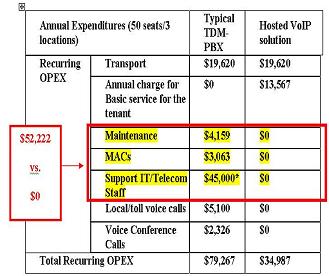
In the table above, note particularly the highlighted area that summarizes how Maintenance, MAC (Moves, Adds, Changes), and Support costs for the an average TDM-PBX can average $52,222 per year while comparative costs for DigiDial-IP are $0. Ease of administration for hosted VoIP service accounts for this enormous gap.
While PBXs and Key Systems have become somewhat easier to use in recent decades, they remain complex systems that generally require expert in-house or outsourced management by a telephony professional. To demonstrate this, we will walk through the basic process of adding a new user to show that even simple MACs (Moves, Adds, and Changes) require complex steps using counterintuitive interfaces.
Comparison of Steps Required to do a Move/Add/Change (PBX vs DigiDial-IP)
PBX Step 1: Access Main Menu. The following illustration is a standard PBX Main Menu taken from a PBX system. Accessing this menu is the first step for all MAC activities.
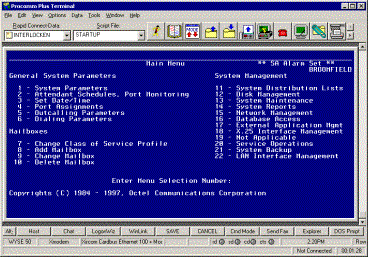
Office Administrator (OA) Step 1: Access Main Menu and Click New. Contrast this menu with the User Interface for the OA where the first step to add a new user is to click the "new" button on the main Employees page.
OA Step 1:
Click "Add"
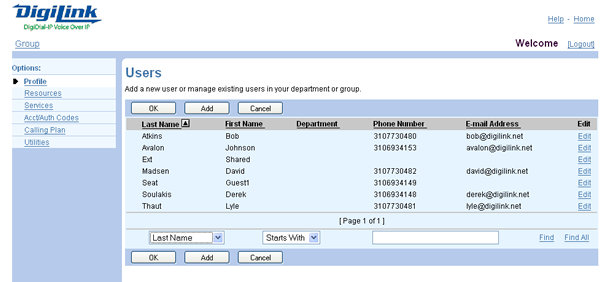
PBX Step 2: Add a Port. The next step to add a new user is to add a port for the user. This step highlights the fact that all users within a PBX system are "hard-wired" to the telephone. There must be wiring installed end-to-end to provide connectivity. This activity alone could consume days waiting for wiring to be complete.
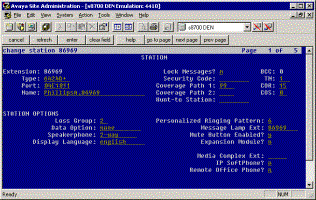
PBX Step 3: Add a Station. Once connectivity has been established in the PBX environment, the next step is to go to another menu to create the station linked to the number established so that the number can be linked to the port assigned in the previous step.
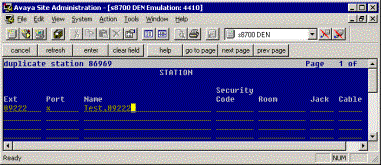
PBX Step 4: Add Voicemail. After the station and port have been established, the PBX administrator then needs to go to an entirely different program to add a voicemail account for the new user at a fairly complex command line interface. (Note that conferencing services, if available, would also need to be assigned separately.)
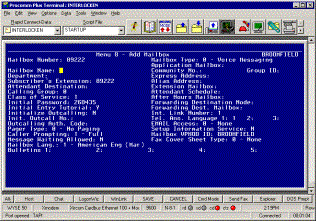
PBX Step 5: Update Patch Panel. Finally, to complete the connectivity for the new user, the telephony administrator must make necessary adjustments to the patch panel to connect the new port to the new user's equipment. Performing these connections requires experience and training as the ports are often difficult to identify and it requires expertise to complete the connections correctly.
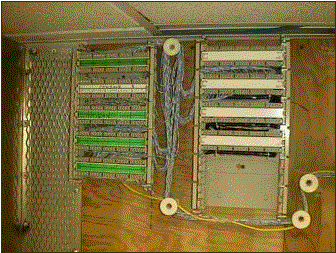
OA Steps 2-4: Adding a New User. Since no hard wiring is needed, there are few parallel steps in the DigiDial environment; the local area network provides the connectivity automatically from any location with an Ethernet port when the telephone is connected to the network. As you can see in the illustration below, all that is required is to go to two screens within the OA interface to describe the user and then select the services they require.
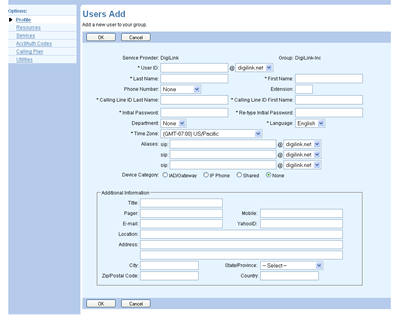
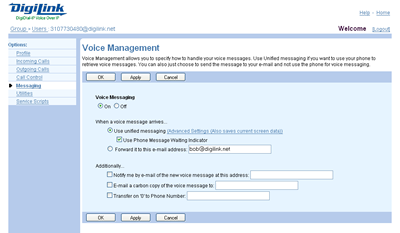
PBX and OA Final Step: Plug-in and Bind Phone. For both the PBX and the OA, the final step is to go to the actual user station to plug-in the phone and bind it to the system. For this step as well, the OA remains the simpler solution as you can see from the summary of the two processes below:
Binding the Phone in the DigiDial-IP environment (after building user and assigning number in the OA) (good solution):
- Plug the phone into your network and turn it on*. Automatic download of software and registration of phone occurs - this takes just a moment in most cases.
- No on-site personnel required - can be performed by end user
- Any phone can be used
- Portability anywhere in the tenant once a phone has been bound
Binding the Phone in a PBX environment (bad solution):
- Go to the closet to configure cabling
- Phone must be pre-configured for the planned location
- Binding similar to (3)Tone Business process, but it can involve a more elaborate coding sequence
- Requires actual physical proximity to phone and patch closet
- * Specific to a set of cables - the only phone that can bind is the designated, preconfigured phone
As you can see from the description of the steps required, it is clear why a trained telephony professional is needed to perform this activity in a PBX environment, and it is just as clear that any office administrator with basic computer familiarity could perform the steps using the OA interface. It is this great difference in complexity that makes it possible for users to significantly save operating expenses by choosing a hosted VoIP solution.
The above example of what it takes to add a user to a PBX system only begins to scratch the surface of the ease of administering our DigiDial-VoIP service. So many tasks that are usually headaches on a PBX system to deal with, such as when user's forget their voicemail passwords, or when features need to be added or changed on user's lines are now just a point and click task. Our administration portal also provides complete contect sensitive online help to further clarify and assist with every single function and feature.
Consider the many indirect costs that are involved each time a PBX system needs a modification; the time it takes to contact the PBX support preson, explain to them what needs to be done, take time to meet with them to verify their work, the missed appointments and all of the other non-productive time that is spent on such activities as well as the time and productivity that is lost waitig for the PBX changes to be made.
With DigiDial-VoIP all changes can be made quickly with just a point and click on any web browser as soon as they are needed, minimizing the indirect costs and the impact to your company's business.

